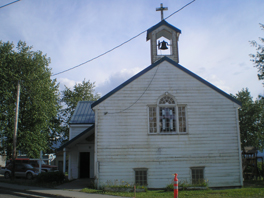The kitchen area of the one-room Hoonah Presbyterian Church bustles with activity as members prepare a pot-luck supper that will proceed the session meeting.
Two years ago, such a scene was unthinkable. "The church had imploded," says Kathy Ruddy frankly. Ruddy, an elder in Chapel by the Lake Presbyterian in Juneau — the state capital, which is four hours from Hoonah by ferry — has been serving on an Alaska Presbytery administrative commission for the Hoonah congregation.
Like many of the Alaska Native village Presbyterian churches scattered around the islands of southeast Alaska, the Hoonah church has relied on lay pastors for much of its century-old life. In 2008, when the PC(USA)’s last Commissioned Lay Pastor left Hoonah, Alaska Presbytery could not find a successor and so struck an agreement with the Missouri Synod Lutherans to keep the congregation alive. "We wanted to keep a Protestant presence in Hoonah," says the Rev. David Dobler, interim executive for the presbytery.

A recent session meeting (clockwise from left) the Rev. David Dobler, executive for Alaska Presbytery; Paul Comoli, holding daughter Sophia; Kathie Deitering, clerk of session; Diane Woitte, treasurer; Marjorie Carlson; Don Bolton.
After a disastrous year in which "an oral contract for open communion and the inclusion of women was repeatedly broken," Dobler said, the Lutherans abandoned Hoonah, a Tlingit (pronounced "Klink-it") village of 800 near Icy Strait on Chichigof Island west of Juneau.
Two Alaska Native Presbyterian patriarchs, the Revs. Walter Soboleff and Henry Fawcett, insisted that the church in Hoonah had to continue, so Alaska Presbytery created the commission to see what could be done.
It wasn't the first time the Hoonah Presbyterian Church had been threatened with extinction.
The church building — and most of the rest of Hoonah — was destroyed by fire in 1945 when U.S. military oil drums that had been stored underneath the docks along the shore during World War II ignited. "It blew up the whole town," Soboleff recalls, "and when I showed up the next day (from Juneau), the townspeople were very unhappy."

The church bell is all that remains of the original Hoonah Presbyterian Church building, destroyed by fire in 1945.
All that remains of that original church building is the bell. "But the church survived, as they almost always do," Ruddy said.
As in 1945, the hardy Presbyterians of Hoonah have survived the disaster of 2008. A five-member session has been reconstituted. The Rev. Ron Horn, pastor of Haines Presbyterian Church — a 6-7 hour ferry ride from Hoonah, depending on the weather — and chair of the presbytery's Committee on Ministry, shares moderatorial duties with Dobler.

A banner in the entryway of Hoonah Presbyterian Church blends Tlingit symbolism with the seal of the PC(USA).
Hoonah Presbyterian Church, which throughout its history has led efforts to improve education, health care, housing and the Native heritage of its community "is on the verge of bursting into a new era of vitality," Ruddy says.
Katherine Bolton, whose grandparents helped build the church that burned and whose parents helped build the replacement church on the same site, proudly shows a banner that is hung in the entryway of Hoonah Presbyterian Church. On the banner — mainly in the traditional Tlingit colors of red, black and white — are a raven, an eagle and a dove.
The raven and eagle represent the two branches of the Tlingit "family tree" and the dove is the Christian symbol for peace and unity. "This is my hope," says Bolton. "Of course there have been disputes about customs, traditions, hair, clothing.
"But there's never been a dispute about God."

